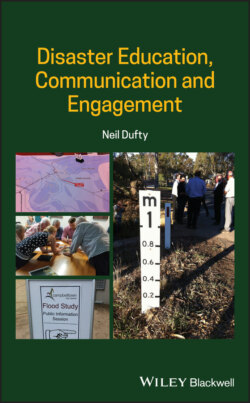Читать книгу Disaster Education, Communication and Engagement - Neil Dufty - Страница 10
2.1.3 Learning Relationships
ОглавлениеEducation has traditionally been seen as a pedagogic relationship between the teacher and the learner. It was always the teacher who decided what the learner needed to know and, indeed, how the knowledge and skills should be taught. For disaster education, ‘pedagogy’ relates to formal and non-formal learning modes usually with children through a prescribed curriculum or course.
Knowles (1970) distinguished between how adults and children learn and coined the term ‘andragogy’. It is based on the premise that adults are independent and strive for autonomy and self-direction. Andragogical learning is task or problem centred.
Andragogy was an important landmark in teaching and learning practices in vocational education and training and in higher education. The principles of adult learning that were derived from it transformed face-to-face teaching and provided a rationale for distance education based on the notion of self-directedness. However, it still has connotations of a teacher–learner relationship.
For disaster education, andragogical learning generally fits within the non-formal learning mode, as for adult education there are course requirements. For higher education courses, disaster-related education (e.g. degrees in emergency management, MOOCs) mainly follows pedagogical principles.
Much of the disaster-related learning is provided by emergency agencies for at-risk people and their communities. As discussed earlier, this is usually conducted through informal learning, although delivered in a pedagogical manner, i.e. in a way similar to a teacher–pupil relationship where the agency ‘knows best' and provides the required knowledge and skills.
Due to the power in disaster education emanating largely from government emergency agencies through pedagogical practices, some people can be excluded or feel disillusioned with learning. For example, Preston (2012) posits that ‘there are both tacit and overt reasons why disaster education shares racial inequalities in common with other forms of formal (and informal) education’. He shows that although there are diverse forms of disaster education they are inextricably linked to a range of inequalities in society.
One way to counter this power inequality issue is through another learning relationship. ‘Heutagogy’ is the study of self-determined learning and draws together some of the ideas presented by these various approaches to learning. It is also an attempt to challenge some ideas about teaching and learning that still prevail in teacher-centred learning and the need for ‘knowledge sharing’ rather than ‘knowledge hoarding’.
Rogers (1969) suggests that people want to learn and have a natural inclination to do so throughout their life. Indeed, he argues strongly that teacher-centred learning has been grossly overemphasised.
A heutagogical approach recognises the need to be flexible in the learning where the ‘teacher’ provides resources but the learner designs the actual course he or she might take by negotiating the learning. Thus, learners might read around critical issues or questions and determine what is of interest and relevance to them, and then negotiate further reading and assessment tasks.
The heutagogical approach has potential for disaster learning as it relates to informal and incidental education. It ties well with the concept of ‘shared responsibility’ (Council of Australian Governments 2011) where both emergency agencies and at-risk people have responsibilities before, during, and after disasters. Coupled with these responsibilities is the requirement for people to learn themselves, although there will be times (e.g. early warning) when emergency agencies need to provide direct advice (e.g. the need to evacuate).
